Abstract
1. Human perceptual learning in discrimination of the oblique orientation was studied using psychophysical methods. Subjects were trained daily to improve their ability to identify the orientation of a circular 2.5 deg diameter unidimensional noise field. Dramatic improvements in sensitivity to contour orientation occurred over a period of 15-20 days. The improved performance persisted for several months. Improvement was more evident between daily sessions than within sessions. This was partly due to fatigue interfering with the learning effect. Moreover, a consolidation period seemed to be required. 2. Improvement was restricted to the position of the stimulus being trained. This position dependency of the learning effect proved very precise. After training at a specific stimulus position, merely displacing the stimulus to an adjacent position caused a marked increase in thresholds. 3. No transfer of the training effect was observed between orientations. Following a shift of 90 deg away from the trained orientation, performance fell, even below the initial level. 4. We observed complete to almost complete transfer between the two eyes. 5. Our results suggest plastic changes at a level of the visual processing stream where input from both eyes has come together, but where generalization for spatial localization and orientation has not yet occurred.
Full text
PDF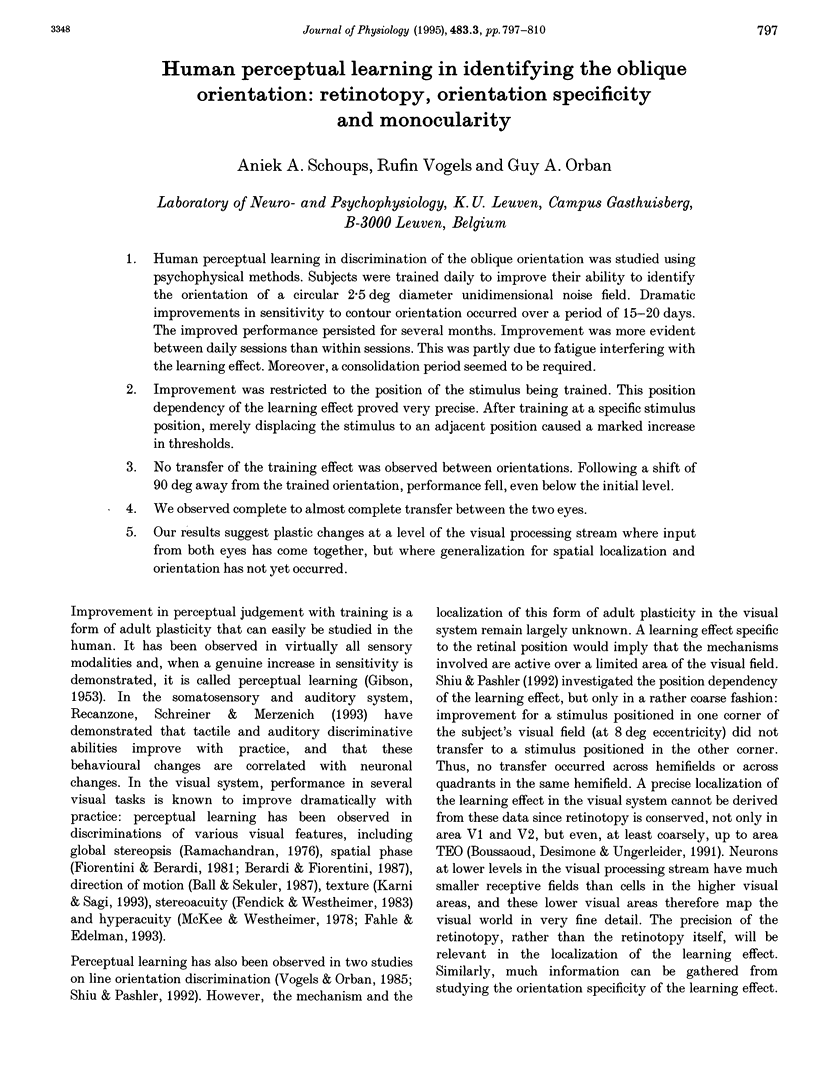
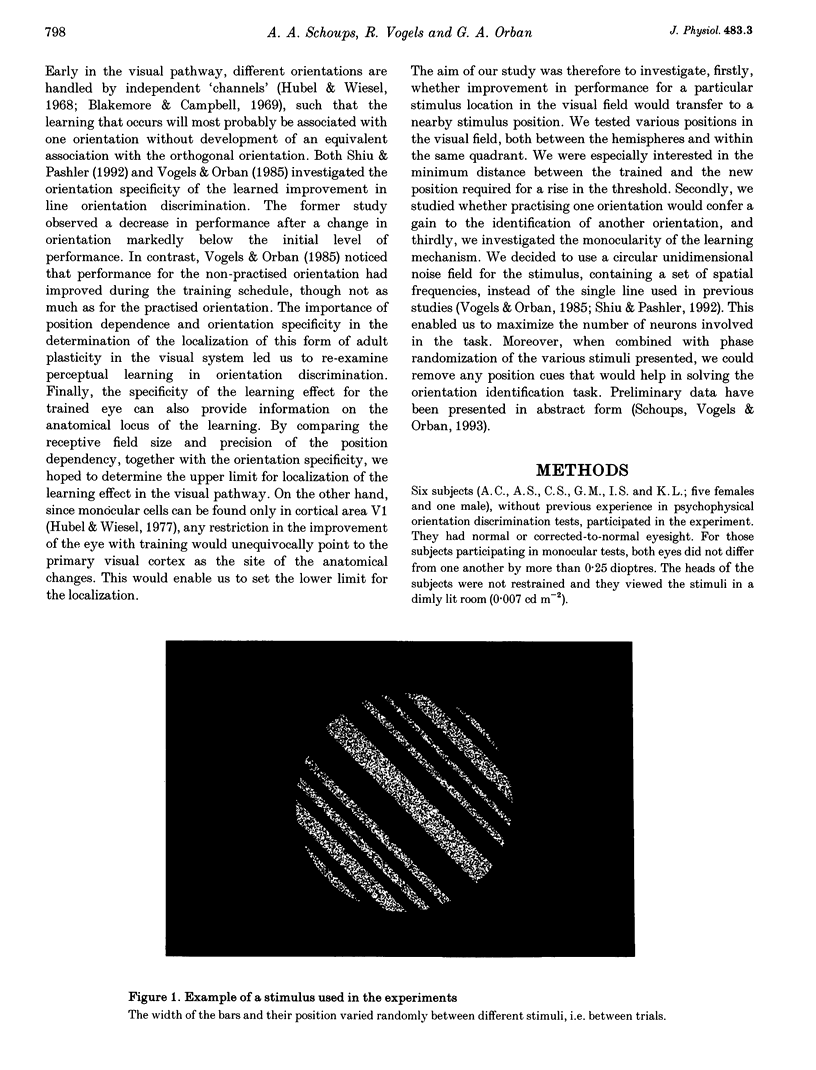
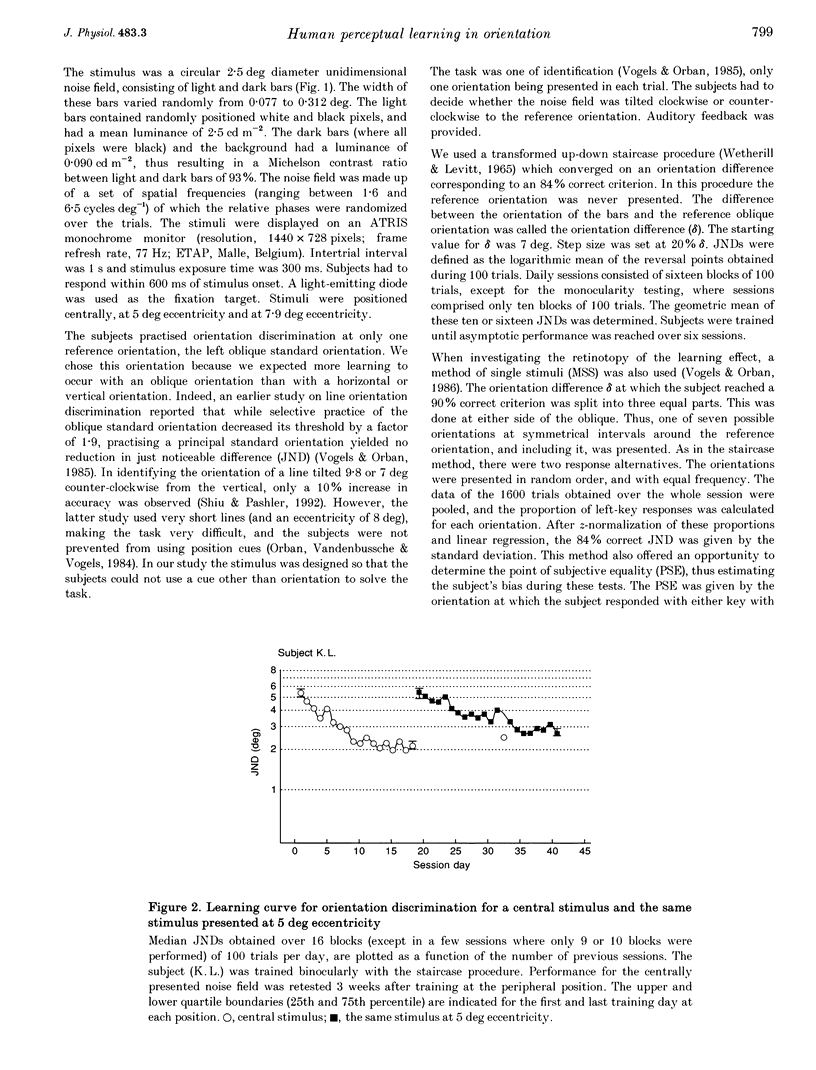
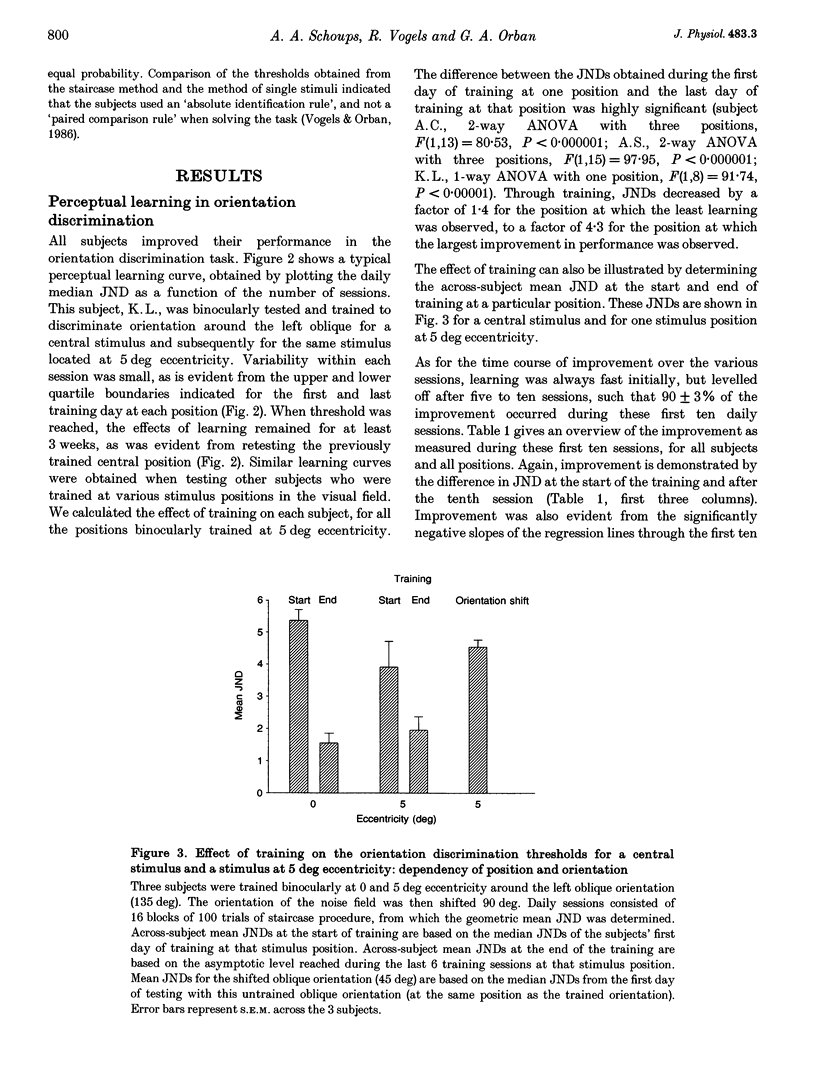
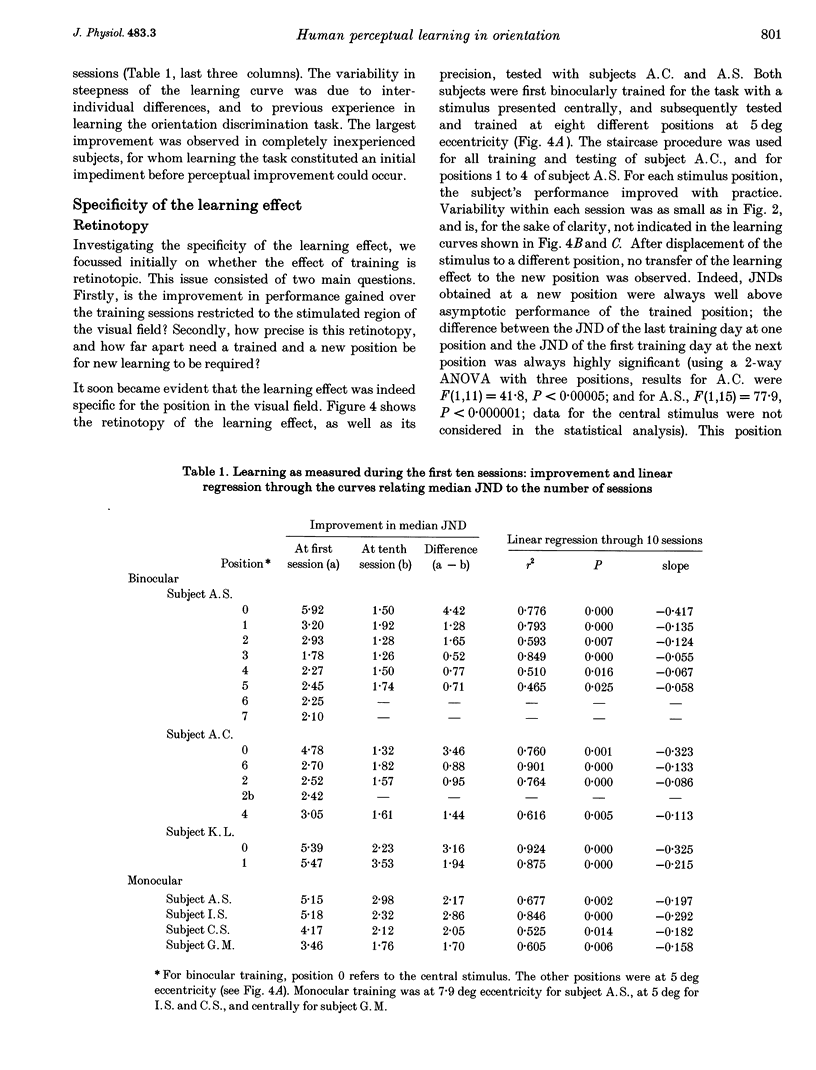
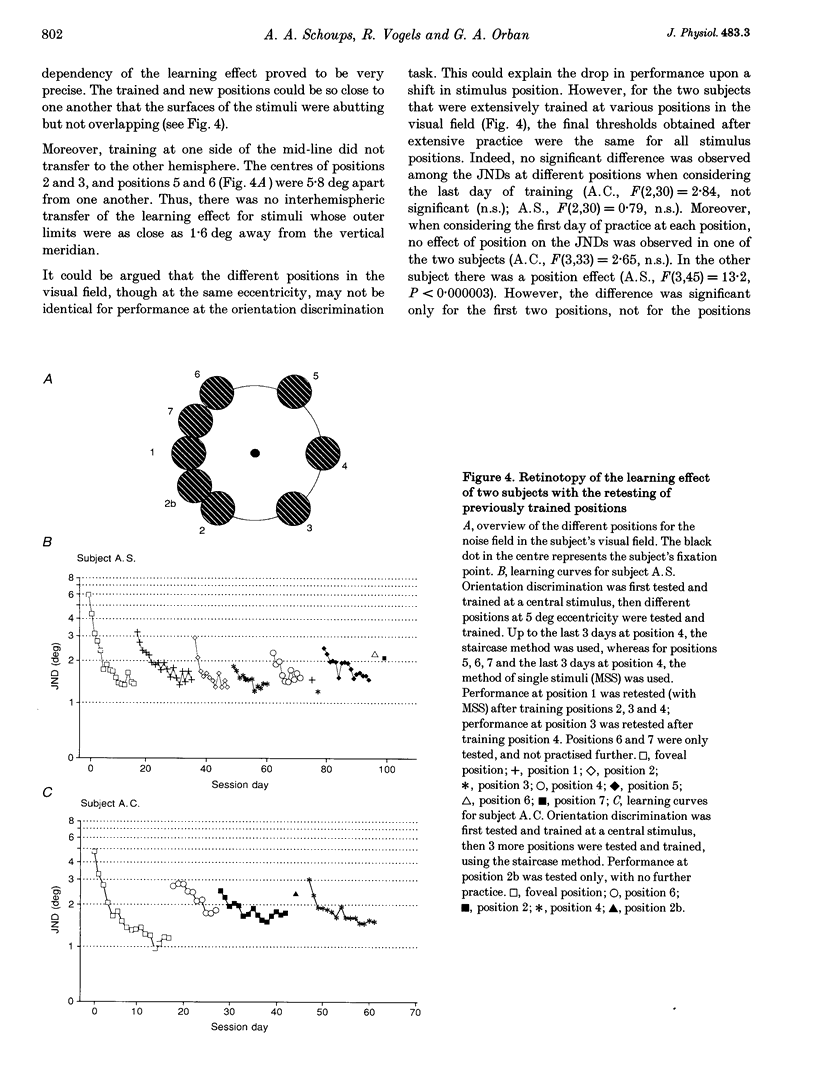
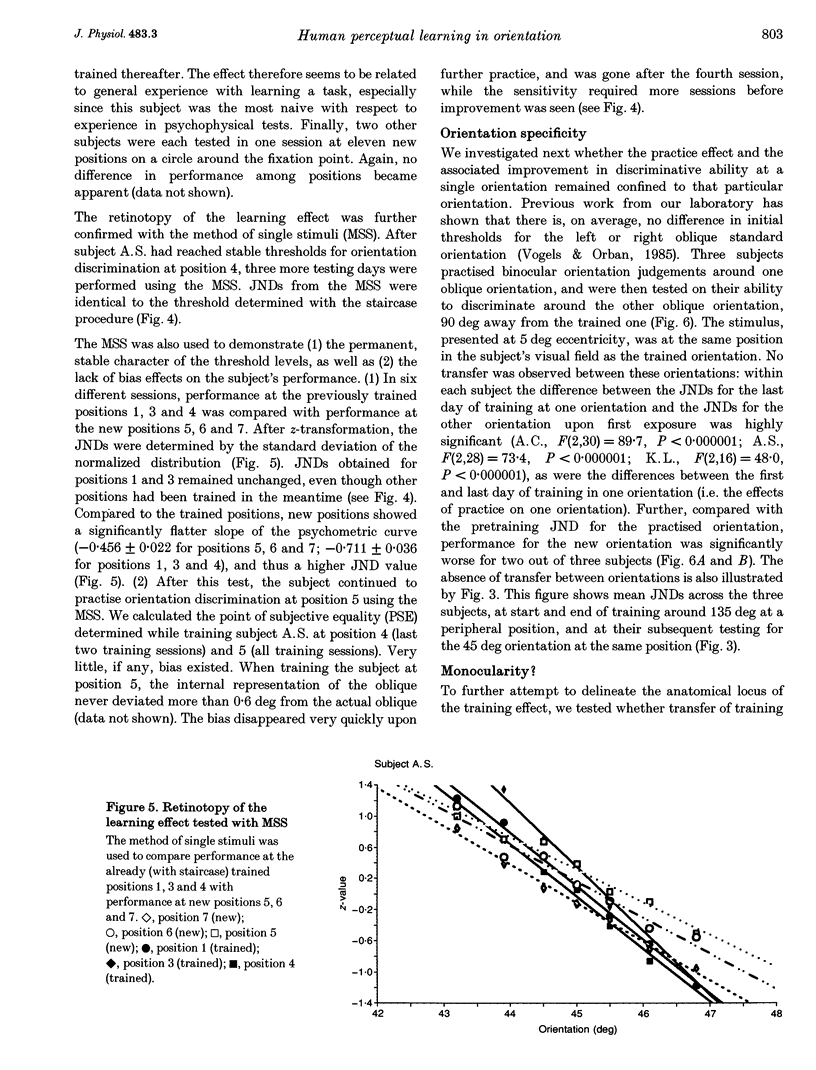
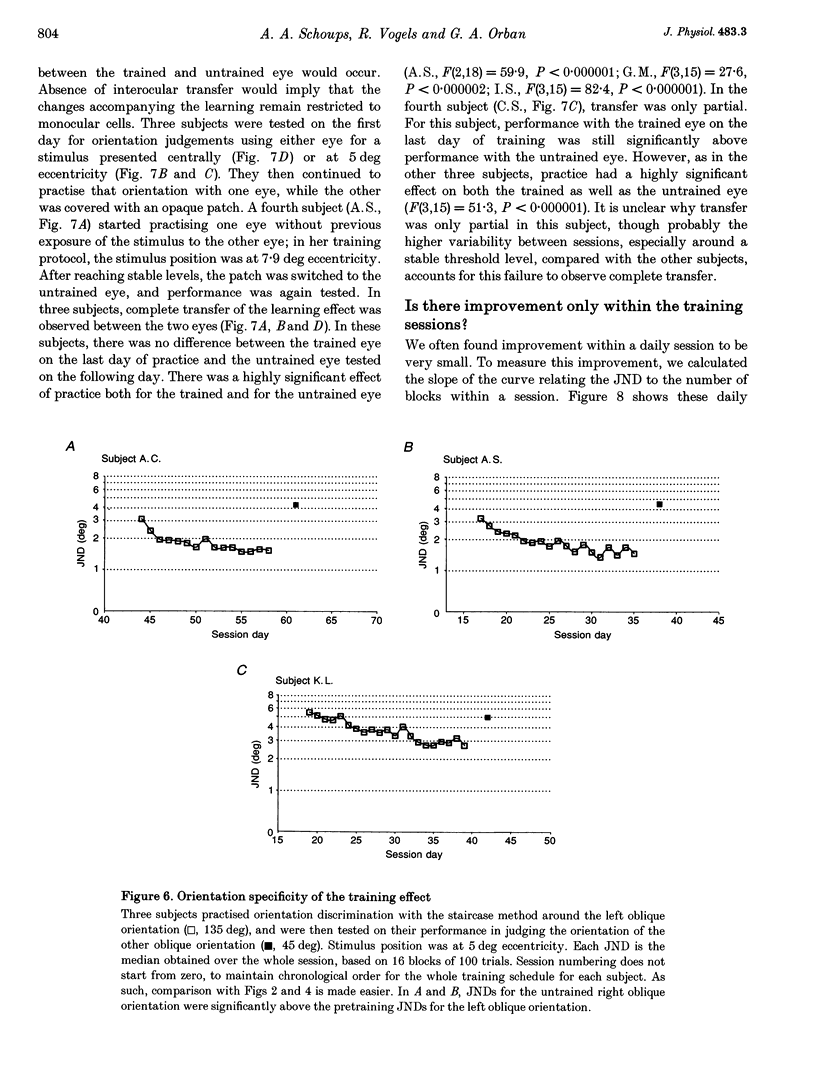
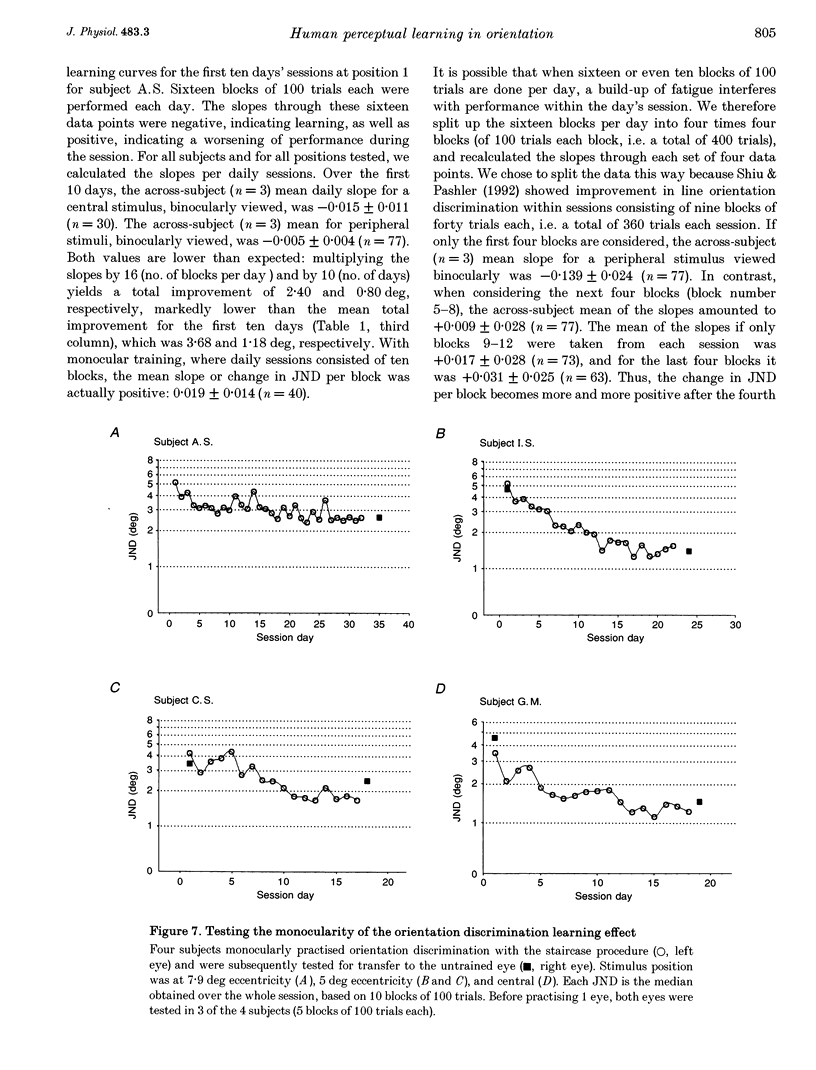
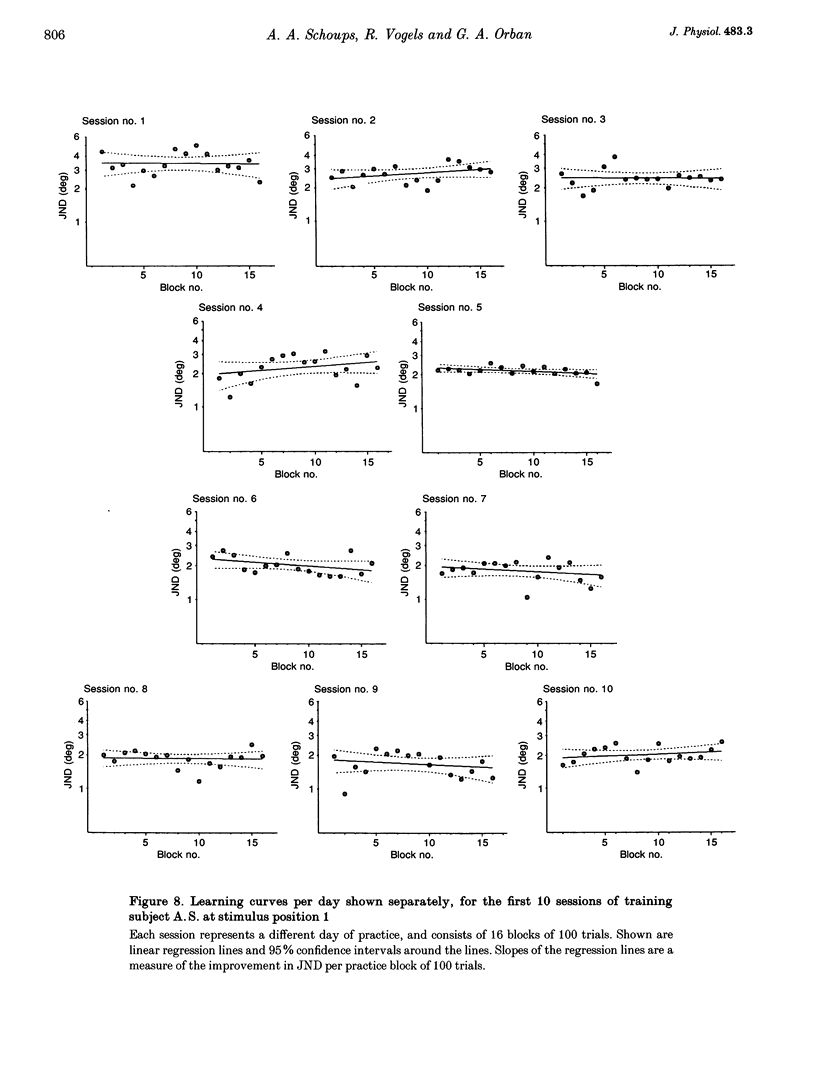
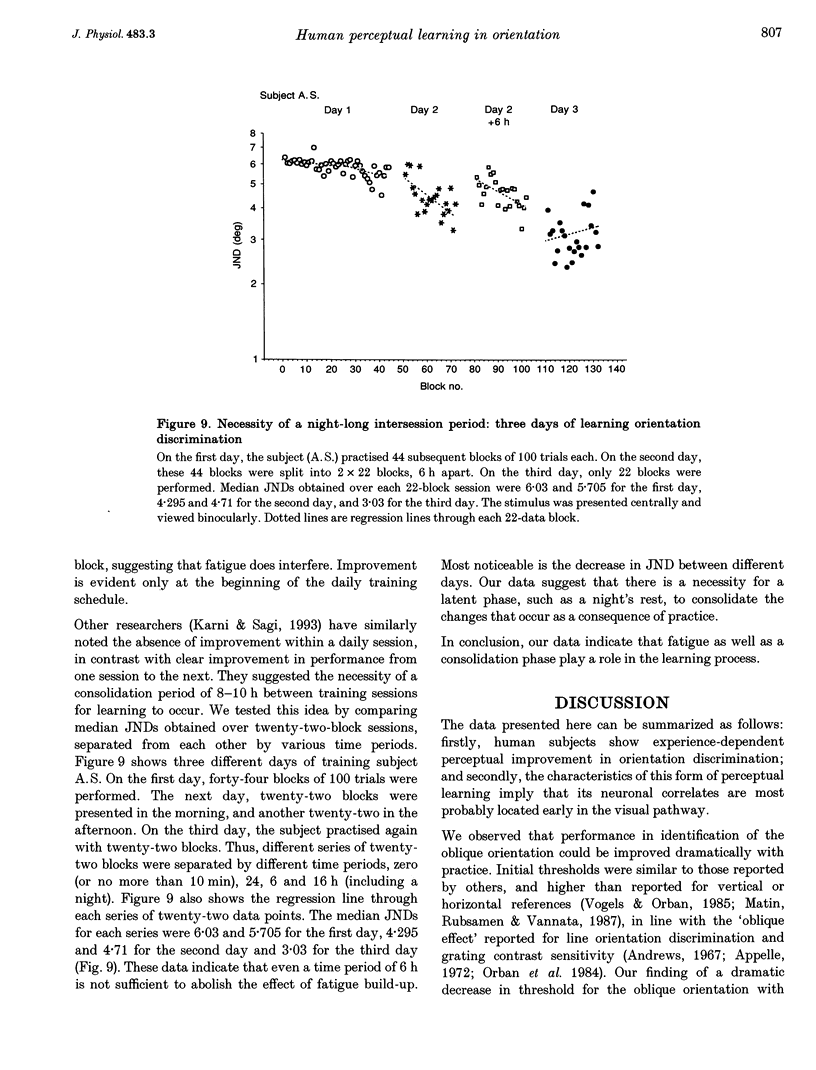
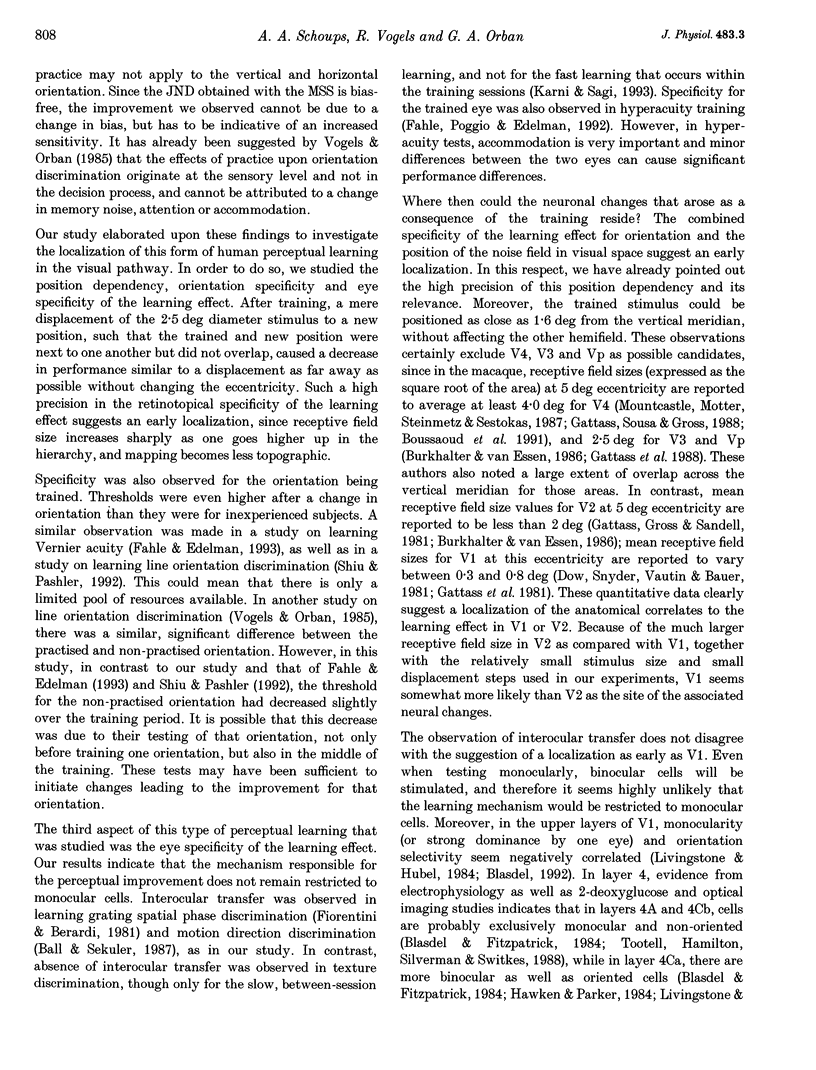
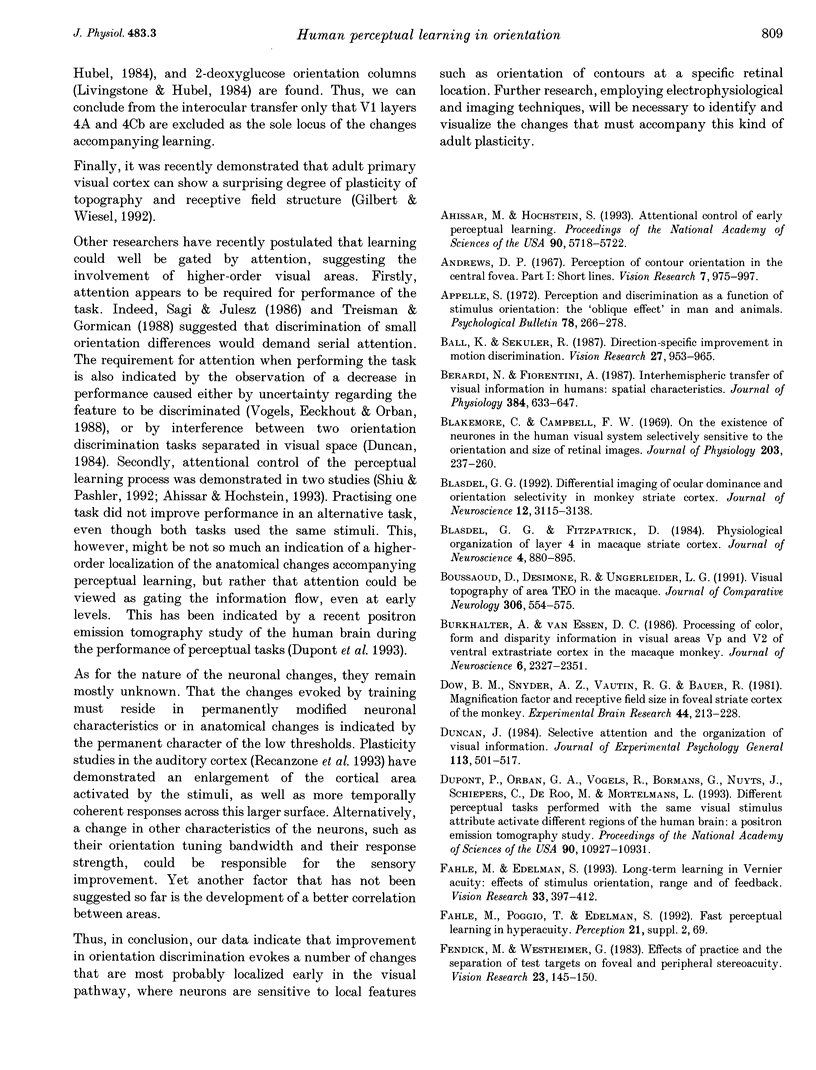
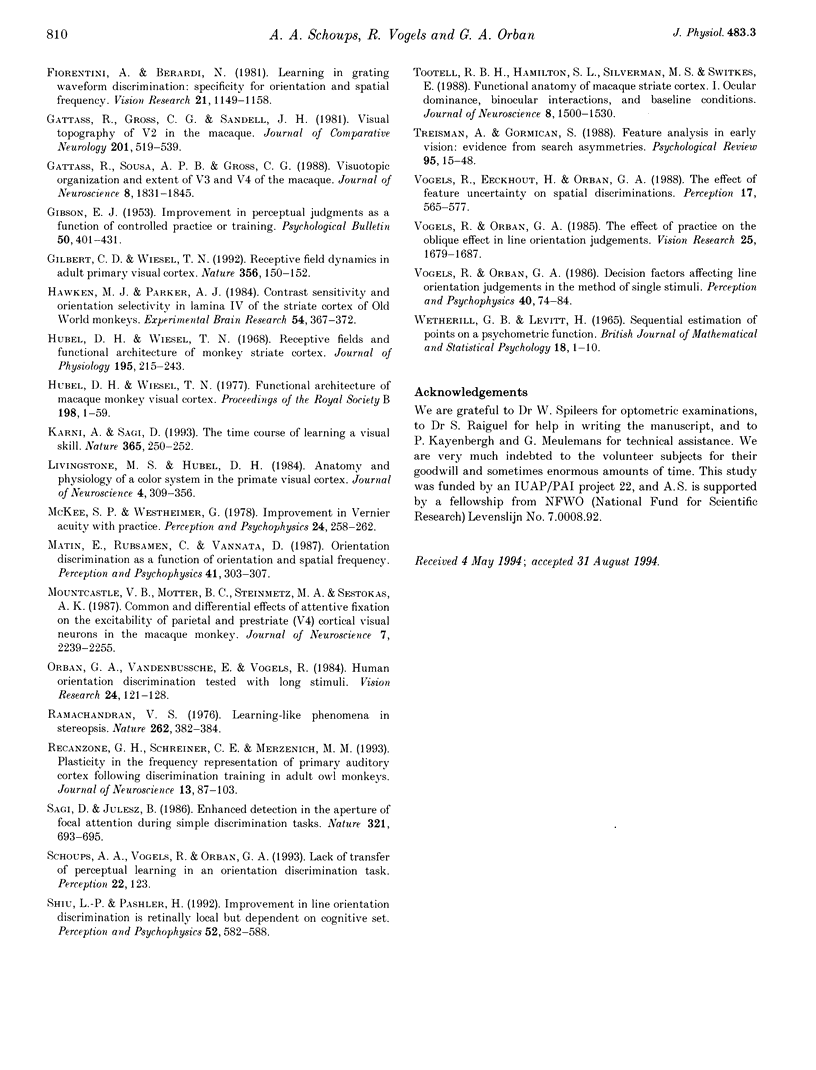
Selected References
These references are in PubMed. This may not be the complete list of references from this article.
- Ahissar M., Hochstein S. Attentional control of early perceptual learning. Proc Natl Acad Sci U S A. 1993 Jun 15;90(12):5718–5722. doi: 10.1073/pnas.90.12.5718. [DOI] [PMC free article] [PubMed] [Google Scholar]
- Andrews D. P. Perception of contour orientation in the central fovea. I: short lines. Vision Res. 1967 Nov;7(11):975–997. doi: 10.1016/0042-6989(67)90014-4. [DOI] [PubMed] [Google Scholar]
- Appelle S. Perception and discrimination as a function of stimulus orientation: the "oblique effect" in man and animals. Psychol Bull. 1972 Oct;78(4):266–278. doi: 10.1037/h0033117. [DOI] [PubMed] [Google Scholar]
- Ball K., Sekuler R. Direction-specific improvement in motion discrimination. Vision Res. 1987;27(6):953–965. doi: 10.1016/0042-6989(87)90011-3. [DOI] [PubMed] [Google Scholar]
- Berardi N., Fiorentini A. Interhemispheric transfer of visual information in humans: spatial characteristics. J Physiol. 1987 Mar;384:633–647. doi: 10.1113/jphysiol.1987.sp016474. [DOI] [PMC free article] [PubMed] [Google Scholar]
- Blakemore C., Campbell F. W. On the existence of neurones in the human visual system selectively sensitive to the orientation and size of retinal images. J Physiol. 1969 Jul;203(1):237–260. doi: 10.1113/jphysiol.1969.sp008862. [DOI] [PMC free article] [PubMed] [Google Scholar]
- Blasdel G. G. Differential imaging of ocular dominance and orientation selectivity in monkey striate cortex. J Neurosci. 1992 Aug;12(8):3115–3138. doi: 10.1523/JNEUROSCI.12-08-03115.1992. [DOI] [PMC free article] [PubMed] [Google Scholar]
- Blasdel G. G., Fitzpatrick D. Physiological organization of layer 4 in macaque striate cortex. J Neurosci. 1984 Mar;4(3):880–895. doi: 10.1523/JNEUROSCI.04-03-00880.1984. [DOI] [PMC free article] [PubMed] [Google Scholar]
- Boussaoud D., Desimone R., Ungerleider L. G. Visual topography of area TEO in the macaque. J Comp Neurol. 1991 Apr 22;306(4):554–575. doi: 10.1002/cne.903060403. [DOI] [PubMed] [Google Scholar]
- Burkhalter A., Van Essen D. C. Processing of color, form and disparity information in visual areas VP and V2 of ventral extrastriate cortex in the macaque monkey. J Neurosci. 1986 Aug;6(8):2327–2351. doi: 10.1523/JNEUROSCI.06-08-02327.1986. [DOI] [PMC free article] [PubMed] [Google Scholar]
- Dow B. M., Snyder A. Z., Vautin R. G., Bauer R. Magnification factor and receptive field size in foveal striate cortex of the monkey. Exp Brain Res. 1981;44(2):213–228. doi: 10.1007/BF00237343. [DOI] [PubMed] [Google Scholar]
- Duncan J. Selective attention and the organization of visual information. J Exp Psychol Gen. 1984 Dec;113(4):501–517. doi: 10.1037//0096-3445.113.4.501. [DOI] [PubMed] [Google Scholar]
- Dupont P., Orban G. A., Vogels R., Bormans G., Nuyts J., Schiepers C., De Roo M., Mortelmans L. Different perceptual tasks performed with the same visual stimulus attribute activate different regions of the human brain: a positron emission tomography study. Proc Natl Acad Sci U S A. 1993 Dec 1;90(23):10927–10931. doi: 10.1073/pnas.90.23.10927. [DOI] [PMC free article] [PubMed] [Google Scholar]
- Fahle M., Edelman S. Long-term learning in vernier acuity: effects of stimulus orientation, range and of feedback. Vision Res. 1993 Feb;33(3):397–412. doi: 10.1016/0042-6989(93)90094-d. [DOI] [PubMed] [Google Scholar]
- Fendick M., Westheimer G. Effects of practice and the separation of test targets on foveal and peripheral stereoacuity. Vision Res. 1983;23(2):145–150. doi: 10.1016/0042-6989(83)90137-2. [DOI] [PubMed] [Google Scholar]
- Fiorentini A., Berardi N. Learning in grating waveform discrimination: specificity for orientation and spatial frequency. Vision Res. 1981;21(7):1149–1158. doi: 10.1016/0042-6989(81)90017-1. [DOI] [PubMed] [Google Scholar]
- GIBSON E. J. Improvement in perceptual judgments as a function of controlled practice or training. Psychol Bull. 1953 Nov;50(6):401–431. doi: 10.1037/h0055517. [DOI] [PubMed] [Google Scholar]
- Gattass R., Gross C. G., Sandell J. H. Visual topography of V2 in the macaque. J Comp Neurol. 1981 Oct 1;201(4):519–539. doi: 10.1002/cne.902010405. [DOI] [PubMed] [Google Scholar]
- Gattass R., Sousa A. P., Gross C. G. Visuotopic organization and extent of V3 and V4 of the macaque. J Neurosci. 1988 Jun;8(6):1831–1845. doi: 10.1523/JNEUROSCI.08-06-01831.1988. [DOI] [PMC free article] [PubMed] [Google Scholar]
- Gilbert C. D., Wiesel T. N. Receptive field dynamics in adult primary visual cortex. Nature. 1992 Mar 12;356(6365):150–152. doi: 10.1038/356150a0. [DOI] [PubMed] [Google Scholar]
- Hawken M. J., Parker A. J. Contrast sensitivity and orientation selectivity in lamina IV of the striate cortex of Old World monkeys. Exp Brain Res. 1984;54(2):367–372. doi: 10.1007/BF00236238. [DOI] [PubMed] [Google Scholar]
- Hubel D. H., Wiesel T. N. Ferrier lecture. Functional architecture of macaque monkey visual cortex. Proc R Soc Lond B Biol Sci. 1977 Jul 28;198(1130):1–59. doi: 10.1098/rspb.1977.0085. [DOI] [PubMed] [Google Scholar]
- Hubel D. H., Wiesel T. N. Receptive fields and functional architecture of monkey striate cortex. J Physiol. 1968 Mar;195(1):215–243. doi: 10.1113/jphysiol.1968.sp008455. [DOI] [PMC free article] [PubMed] [Google Scholar]
- Karni A., Sagi D. The time course of learning a visual skill. Nature. 1993 Sep 16;365(6443):250–252. doi: 10.1038/365250a0. [DOI] [PubMed] [Google Scholar]
- Livingstone M. S., Hubel D. H. Anatomy and physiology of a color system in the primate visual cortex. J Neurosci. 1984 Jan;4(1):309–356. doi: 10.1523/JNEUROSCI.04-01-00309.1984. [DOI] [PMC free article] [PubMed] [Google Scholar]
- Matin E., Rubsamen C., Vannata D. Orientation discrimination as a function of orientation and spatial frequency. Percept Psychophys. 1987 Apr;41(4):303–307. doi: 10.3758/bf03208230. [DOI] [PubMed] [Google Scholar]
- McKee S. P., Westheimer G. Improvement in vernier acuity with practice. Percept Psychophys. 1978 Sep;24(3):258–262. doi: 10.3758/bf03206097. [DOI] [PubMed] [Google Scholar]
- Mountcastle V. B., Motter B. C., Steinmetz M. A., Sestokas A. K. Common and differential effects of attentive fixation on the excitability of parietal and prestriate (V4) cortical visual neurons in the macaque monkey. J Neurosci. 1987 Jul;7(7):2239–2255. doi: 10.1523/JNEUROSCI.07-07-02239.1987. [DOI] [PMC free article] [PubMed] [Google Scholar]
- Orban G. A., Vandenbussche E., Vogels R. Human orientation discrimination tested with long stimuli. Vision Res. 1984;24(2):121–128. doi: 10.1016/0042-6989(84)90097-x. [DOI] [PubMed] [Google Scholar]
- Ramachandran V. S. Learning-like phenomena in stereopsis. Nature. 1976 Jul 29;262(5567):382–384. doi: 10.1038/262382a0. [DOI] [PubMed] [Google Scholar]
- Recanzone G. H., Schreiner C. E., Merzenich M. M. Plasticity in the frequency representation of primary auditory cortex following discrimination training in adult owl monkeys. J Neurosci. 1993 Jan;13(1):87–103. doi: 10.1523/JNEUROSCI.13-01-00087.1993. [DOI] [PMC free article] [PubMed] [Google Scholar]
- Sagi D., Julesz B. Enhanced detection in the aperture of focal attention during simple discrimination tasks. Nature. 1986 Jun 12;321(6071):693–695. doi: 10.1038/321693a0. [DOI] [PubMed] [Google Scholar]
- Shiu L. P., Pashler H. Improvement in line orientation discrimination is retinally local but dependent on cognitive set. Percept Psychophys. 1992 Nov;52(5):582–588. doi: 10.3758/bf03206720. [DOI] [PubMed] [Google Scholar]
- Tootell R. B., Hamilton S. L., Silverman M. S., Switkes E. Functional anatomy of macaque striate cortex. I. Ocular dominance, binocular interactions, and baseline conditions. J Neurosci. 1988 May;8(5):1500–1530. doi: 10.1523/JNEUROSCI.08-05-01500.1988. [DOI] [PMC free article] [PubMed] [Google Scholar]
- Treisman A., Gormican S. Feature analysis in early vision: evidence from search asymmetries. Psychol Rev. 1988 Jan;95(1):15–48. doi: 10.1037/0033-295x.95.1.15. [DOI] [PubMed] [Google Scholar]
- Vogels R., Eeckhout H., Orban G. A. The effect of feature uncertainty on spatial discriminations. Perception. 1988;17(5):565–577. doi: 10.1068/p170565. [DOI] [PubMed] [Google Scholar]
- Vogels R., Orban G. A. Decision factors affecting line orientation judgments in the method of single stimuli. Percept Psychophys. 1986 Aug;40(2):74–84. doi: 10.3758/bf03208186. [DOI] [PubMed] [Google Scholar]
- Vogels R., Orban G. A. The effect of practice on the oblique effect in line orientation judgments. Vision Res. 1985;25(11):1679–1687. doi: 10.1016/0042-6989(85)90140-3. [DOI] [PubMed] [Google Scholar]
- WETHERILL G. B., LEVITT H. SEQUENTIAL ESTIMATION OF POINTS ON A PSYCHOMETRIC FUNCTION. Br J Math Stat Psychol. 1965 May;18:1–10. doi: 10.1111/j.2044-8317.1965.tb00689.x. [DOI] [PubMed] [Google Scholar]


